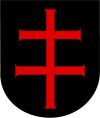Skaryszew
| Skaryszew | |||
|---|---|---|---|
| |||
 Skaryszew | |||
| Coordinates: 51°18′32″N 21°14′55″E / 51.30889°N 21.24861°ECoordinates: 51°18′32″N 21°14′55″E / 51.30889°N 21.24861°E | |||
| Country |
| ||
| Voivodeship | Masovian | ||
| County | Radom | ||
| Gmina | Skaryszew | ||
| Established | 1198 | ||
| Town rights | 1264 | ||
| Government | |||
| • Mayor | Ireneusz Kumięga | ||
| Area | |||
| • Total | 27.49 km2 (10.61 sq mi) | ||
| Population (2006) | |||
| • Total | 3,989 | ||
| • Density | 150/km2 (380/sq mi) | ||
| Time zone | CET (UTC+1) | ||
| • Summer (DST) | CEST (UTC+2) | ||
| Postal code | 26-640 | ||
| Area code(s) | +48 48 | ||
| Car plates | WRA | ||
| Website |
www | ||
Skaryszew [skaˈrɨʂɛf] is a town in Radom County, Masovian Voivodeship, Poland, with 3,922 inhabitants (2004). The town is located on the Kobylanka river, and belongs to the historic province of Lesser Poland. Skaryszew lies on a regional road nr. 733, and for most of its history was part of Sandomierz Voivodeship. In the past it was an important urban center of northern Lesser Poland, with town charter granted to Skaryszew as early as 1264.
History
First documented mention of Skaryszew comes from the year 1198, when the village belonged to the Abbey of Order of the Holy Sepulchre, located at Miechów. The monks opened here a branch of their abbey, and probably in the late 12th century, a wooden church of St. Jacob was built, together with a house for the monks. Due to the efforts of the Order of the Holy Sepulchre, merchants and skilled artisans were attracted to the quickly growing village. Skaryszew was destroyed in the Mongol invasion of Poland, and soon afterwards, Prince of Kraków and Sandomierz Bolesław V the Chaste granted the village the so-called Środa Śląska town charter (Neumarkt-Magdeburger Recht), based on the charter of Nowy Korczyn (see also Magdeburg rights). The charter was confirmed by King Kazimierz Wielki in 1354.
Skaryszew prospered in the late Middle Ages and the Polish Golden Age, but in the late 16th century, it began to decline, at the expense of the quickly developing urban center at Radom. The town had a bath house (late 15th century), Thursday fairs, a brewery, a town hall (before 1618), and a hospital (1629). Like in almost all Lesser Poland’s towns, the period of prosperity definitely ended during the Swedish invasion of Poland, when Skaryszew was ransacked and burned, with most of its inhabitants murdered (1655). By 1670, the population shrank to 363, and Skaryszew did not begin to recover until the 1760s, when the population grew to app. 700. The town became famous for its horse markets, which still exist and which are very popular.
In 1701, a new church was built, with two towers. The shape of Skaryszew’s streets, established in the early 18th century, remains almost unchanged. At that time, most houses were made of timber, which resulted in frequent fires. Skaryszew had a town hall, located in the market square, and following the Partitions of Poland, it belonged to the Russian-controlled Congress Poland (since 1815). In the late 19th century, the population grew to app. 1,300, but in 1869, following the January Uprising, Skaryszew lost its town charter for 76 years. In an 1889 fire, almost whole village was burned, but it was quickly rebuilt.
On July 1, 1922, the government of the Second Polish Republic returned town charter to Skaryszew. In the interbellum period, and in 1945 - 1975, Skaryszew belonged to Kielce Voivodeship. Before the outbreak of World War II, the town’s population was 3,100. On September 8, 1939, Skaryszew was bombed by the Luftwaffe. The war brought destruction to the town, and its Jewish residents perished in the Holocaust.
Horse markets
According to some sources, first horse market at Skaryszew took place in 1432. In 1633, King Wladyslaw IV Waza allowed the markets to be organized on the first Monday after Ash Wednesday, which usually is in mid-March. This tradition has been kept until today. During the 2012 horse market, members of several anti-cruelty organizations protested, claiming that horses are not treated properly by their owners, and those animals which are not sold, are in many cases killed for meat.
Points of interest
- Baroque church of St. Jacob (17th century),
- 19th century Catholic cemetery, with a chapel.
Symbols
Coat of arms: Sable a cross of lorraine gules. Flag: Gules, a wider central pale sable charged with a cross of lorraine of the first.

